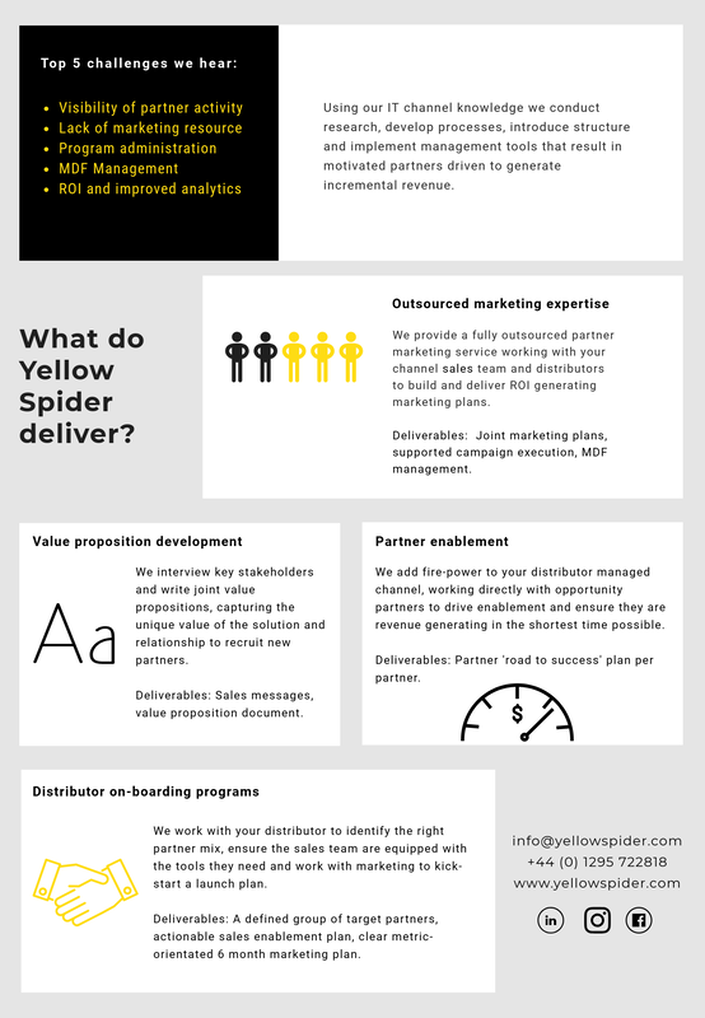 We love data at Yellow Spider, mainly because it provides so much insight that we use to improve our clients marketing outreach. During these times of reflection we are supporting a number vendors who are revisiting and analysing their data to make sure it is providing them with maximum value. Our main focus is to highlight opportunities for growth which are often overlooked or missed. We have developed a tool that combines data and intelligence gathered through the sales and marketing process to identify specific behaviours and buying preferences. This allows us to create groups of customers with similar characteristics resulting in effective segmentation and identify clearly defined groups of opportunities:
This method of segmentation helps to define marketing activities, go to market strategies and messaging for targeted nurture campaigns aimed at driving specific outcomes or responses. It’s powerful insight and is particularly relevant to organisations selling through a two-tier model. Information gathered can be used to strengthen channel relationships and build more effective (and mutually lucrative) engagements through a programmatic approach. The benefits of taking a fresh look at your data are clear and by introducing a regular cadence of analysis patterns start to emerge. Once the framework is in place it’s easy to run the analysis on a quarterly basis as a temperature check or to measure the effectiveness of sales and marketing campaigns. To find out how we can help you maximise your data and optimise your channel engagements please get in touch.
0 Comments
For vendors new to the market, the first two years of building a successful channel are the most difficult. It is likely you already have some established competitors with an established channel and a ‘partner program’ being executed with varying levels of success, all have shiny incentives to grab channel attention. If you’re the new kids on the block and you want to attract and retain new partners, you need to stand out from the crowd. Our advice is don’t run before you can walk. Take time to build your strategy, value proposition and support network before you start recruiting partners, this way you ensure your initial investment in channel development provides a return. Using our experience of working with leading Global IT vendors, we’ve developed our own recipe to channel success. This article outlines the building blocks you should think about before you even start a conversation with a channel partner. It’s all about profile. Knowing the profile of partner that you want to target and how you can attract their attention will focus your marketing efforts on the right people (we advise quality here, not quantity). Don’t fall into the trap of simply buddying up with the biggest names, spend time understanding who is best suited to your business; it could be the ones you least expect! Have a plan. I know, it sounds simple but so many people forget it! Having a clearly defined marketing plan aligned with sales goals is the first step on the road to sustainable revenue for both you and your channel partners. Structure. Be clear on what your channel engagement looks like. That includes knowing how you’re going to work with your distributors as well as understanding what type, and how many, partners you need to join forces with to deliver your strategy. Be attractive. What makes your proposition valuable? Ensure you have a well-defined process for articulating and delivering value to your channel. This could be through a programmatic engagement or a range of benefits delivered via joint marketing arrangements. You can have the best program in the world but unless you communicate product and solution value and offer your channel an opportunity you’ll struggle to grab your partners attention. Support. Establish your support mechanism from the get go. This includes the tools, processes and people you’ll need to manage your channel relationships as well as any training and certification required to sell and support your products. Consider language requirements and how you will support joint marketing initiatives, lead gen activities and market development funds. In the early days, successful vendors support partners with joint marketing planning and campaigns; until you’ve got an established channel it’s a more effective than giving them marketing funds. Easy does it. In a competitive market partners are going to work with vendors who are easy to do business with and ones who make it easy for them to grow their own revenue. Make the onboarding as simple as possible for partners, with plenty of onboarding milestones and clear lines of communication back into your organisation. Partners have access to several different vendor portals so make yours simple with clear training modules and fund management tools that allow partners to track their success and download sales and marketing support materials.
You may have seen our recent blog posts on what we do – B2B channels, outsourced marketing resource , event management and social media management. Plus lots of other clever, B2B marketing stuff. We’re proud of what we do, because we know it drives results for our clients. But this time, instead of focussing again on what we do, I wanted to talk a little about how we do it. More specifically, about where we see the greatest success. One of the greatest benefits of bringing in help from a company like Yellow Spider is that, by definition, we are ‘external’. That means we don’t come with any preconceptions of you, your team or organisation, or what you are trying to achieve. We’re respectful of all of those things. Our team’s combined experience means we have over 100 years B2B marketing know-how. It’s quite likely that not only can we help you with the specific project you’ve hired us for, but that we can also provide added value in the elements that connect to it. ‘Added value’ as a term is so over-used today that I hesitate to re-use it here. But it genuinely drives the Yellow Spider philosophy. We don’t charge in with off-the-shelf solutions. We take time to understand your objectives. We tailor our solution to your circumstances, and where you are trying to get to. We bring structure where there was none. We bring insight from our combined experience working deep within the world’s top tech companies. And fundamentally, we get things done. Sounds simple, doesn’t it? But in today’s business environment, there can be many blockers to progress, or simply achieving objectives. There can be great value in having someone bringing a fresh perspective. All this talk of ‘external’ brings me to the main point of this blog. And that is, that we consistently see the greatest successes within clients where we shed the tag ‘external’ and are considered part of the team. We’re proud to say it’s a position we have earned across our client base. I’ll take a recent example from one of our clients. They have invested heavily, at a global level, in an intent database that aggregates data across their various applications. They aimed to use the data to better target their marketing campaigns. We requested access to this tool and immediately saw the huge, additional value of it in assisting not only the targeting but in marketing strategizing, decision-making and planning. And not only in the country we are charged with supporting, but across EMEA. We took the initiative, and without being asked, invested time to understand the data, manipulate it and compile a ‘story’ to propel a joint marketing and sales program to understand more about these accounts and how our client can win them. It’s something that could only happen because the client considered us one of them – we have access to the same resources, knowledge and people that everyone else in the team has. We’re successful when our client is successful, or more succinctly, we look good when our client looks good. That’s what drives us, individually, collectively and as a business. If we’re not successful, we no longer have a job. There’s an added edge that means we are, and have to be, ‘Marketing+’. It can be hard to admit ‘this could be better!’, ‘we need help!’, or even ‘I don’t know what I’m doing!’. But the potential benefits of doing so are massive. Get in touch for an informal chat about how we might be able to turbocharge your marketing. Or just help you get things done. Because sometimes, we more than understand, it’s just not that simple. Marketing teams often use the terms 'translation' and 'localization' interchangeably. Even field teams who are engaged in both processes tend to default to the term 'translation'. They are however, very different, and our understanding of those differences is part of the bigger picture of how our audiences engage with us, so it is vital that we have a solid grasp of how they are distinct. Translation is literal, but whilst this means that the text will be expressed 'word for word', grammar and syntax need to be taken into account if the translated text is to make sense. However, whilst translation makes allowances for the differences in the structure of languages, it makes no attempt to interpret the content to ensure that the meaning is something the reader would expect and understand. That is where localisation comes in. Before we come to that, it is interesting to note that some content is deliberately translated rather than localised to ensure it is strictly uniform. Publication groups delivering technical, process, procedural and legal documentation may treat content this way out of choice. In these specialised use cases this can be a valid approach because the content is much less subject to cultural influences. In some use cases, such as safety critical equipment documentation, it might actually be dangerous to interpret the translation in order to localise it. For other uses, and particularly for customer facing content, we apply localisation, as our goal is not just to translate the text but to ensure it is truly equivalent to the source text on the audience's terms. There is more work involved in achieving this. An article inComputer World describes the process well: "This is a more involved process whereby the target-language content is adapted to more effectively convey a similar meaning or connotation in the target culture. Idiomatic expressions, puns and marketing material generally fall into this category, but localization can apply to any type of content based on what your business objectives are. The key point here is that your target-language version will often not be a literal translation. As an example, if you want to convey the phrase "Like father, like son" in Chinese, it would read as something like "Tigers do not breed dogs." Although this doesn't match up with the source content, it has the same connotation in the target culture." Localisation goes beyond the translation of words to ensure that one piece of content is equivalent to another in how the audience will engage with it. To do this it has to address word selection, particularly in adjusting the tone, the use of expressions (many of which do not translate very well) and any references made. Excellence in localisation requires attention to details such as capitalisation (which is different between German and English for example) and any salutation used (some countries expect the salutation to align with academic qualifications). Failure to pay attention to how the audience expects to be communicated with will inevitably result in lower engagement. Ultimately, localisation has to interpret the objectives of the content and adapt it to meet those objectives. This requires local knowledge, not just of the language but of the people of the country or region; including how they think, conduct business, and live their lives. It requires empathy, which can be defined as 'the ability to understand and share the feelings of another.' If this sounds overly sentimental, it isn't - it is good business and helps establish sound foundations for engaging with an audience. Corporate Visions use the phrase 'talk to me like you like me' to capture the empathy necessary to build engagement, and that is an essential part of Marketing today. The fact that our audiences are different, and that engaging them requires some local knowledge, is part of what makes Marketing such an interesting profession.
Marketing automation solutions can revolutionise the effectiveness and understanding of your campaigns, but choosing the right one is critical. Many put off the decision for as long as possible due to the investment required both in man hours and finances so when the time comes and you need to bite the bullet you want to know you have selected the right one for your business. Here I share with you my 6 advices for a quick evaluation of marketing automation platform. If you follow these key rules you will have a platform that is fit for purpose and meets your marketing requirements: Functionality What do you actually want the platform to do for your business? Sounds like a simple question but it’s easy to get distracted by the advanced features some platforms offer. Be really clear on what it is that you need it to do and only look for the features you will have an use for. Timeframe The amount of time you have to implement a new marketing automation platform will help you decide whether you go down the ‘built your own’ route or select an ‘off the shelf’ product. Both have their pros and cons but bear in mind that regardless of which route you choose it’s going to be at least eight to 12 weeks before you have a fully functioning platform. Integration How is the new platform going to integrate with any existing tools you currently use? If you have a CRM system it is worth talking to your existing supplier to see whether they have a suitable marketing platform as well. This could save time, cost and will ensure all of your on line tools work harmoniously. Scale Make sure you select a platform that can grow with your business. You are probably clear on the functionality needed today but what does your business look like in five years’ time and does the platform you are considering offer the ability to scale up when you need it to? Ease of use Despite all of us being IT savvy and more than capable of driving on line and self-serve technologies, make sure the tool you select doesn’t require a master’s degree to understand it! It only takes one bad experience to put an employee or partner off using a platform no matter how great it is so make sure you evaluate the user experience. Success metrics As with any marketing activity you need to be able to demonstrate success and ROI. Choose a platform that allows you to create, view and export reports that show how your campaign has performed and identifies trends that will shape future campaigns. Over recent years we have seen how the perception of marketing has evolved from being a cost centre to playing a fundamental role in driving and generating sales revenue. Demand generation has got sophisticated, and use of data has allowed marketing teams to achieve results that we only dreamt of years ago. Here we outline our top 5 tips to help you drive the most opportunities from your demand marketing strategies. Plan multi-touch, integrated campaigns. The days of single activity campaigns are over. The way we consume content in this digital age means we need to evolve our marketing tactics and use digital to drive awareness and action. It will take multiple touches before your audience will engage with you. Within each of your campaigns plan a mix of tactics, content and media to plan for a minimum of seven engagements or touches with your audience. Tailor your campaigns. A savvy buyer is spoilt. We have all come to expect the information we need to be presented to us in a way we wish to consume it. So take this philosophy and apply it to your messaging. Spend some time with sales learning about your customers, and build up a picture of what the buying groups look like. Then create message frameworks to tailor the message you want to give, to make it relevant to your segmented audience. Use the same thinking to tailor the way you deliver the message. Do your technical communities like a different style of communication to the CEO? Yes, more than likely. Adopt lead qualification and lead scoring. Understanding the leads you gather, and how best to follow them up is an often over looked part of the demand process. But if you think about it logically, are all leads created equal? To score your leads you must first create a scorecard against which all your leads can be measured. These typically follow the BANT methodology (Budget, Authority, Need, Timeline), but consider too other factors depending on your lead source - you can ascertain interest from event leads where you’ve had a conversation with the prospect, engagement through a digital campaign where you can track their behaviour and demographics where you have data available to understand a prospects company and situation. Use the scorecard to define your lead follow up strategy - Which need immediate follow up? Which need nurture? Which to disqualify? Nurture your prospects. Like every good gardener knows, nurturing young seedlings will grow strong healthy plants. Work with sales to understand the sales cycle, agree clear sales stages and decide what support and content you can provide to your prospects to help move them through the stages. Then devise a content plan and nurture campaign to deliver timely, relevant messages to support your prospect’s buying decisions. Build a relationship with sales. As you’ve hopefully picked up on so far, none of this can be achieved without the support and buy in from sales. You need mutual trust and respect between sales and marketing, with shared language, common goals and agreed processes - only then can your demand strategy reach it’s potential. Most IT vendors have a well-developed network of channel partners, some have hundreds of partners; others have thousands. They have invested time in finding, enabling and motivating these partners to perform as an extension to the sales function however it’s not uncommon to see the majority of channel revenue coming from a select number of ‘top’ partners. When you consider that the majority of a vendor’s revenue can flow through indirect channels, it’s worth asking yourself a simple question from time to time…. ‘Do we have the right partners to drive the revenue we’d like?’ Commitment Are your partner’s committed to your product or solution offering? A partner who is truly committed to a vendor is enrolled in their partner program, they have a marketing strategy that is aligned to the vendors and they are actively promoting and selling the complete solution set. They have a value proposition that is aligned to yours and most importantly they are hitting their quarterly sales target. Capability Do your partners have the capability to take your products or solutions to market? To act as an extension of a vendors sales force a partner needs to have an established telesales function, with access to the right end user markets and they need to hold the necessary sales and technical qualifications so that you know they have the skills to market and sell your products effectively. Capacity Do your partners have the capacity to accommodate you as a vendor? Most partners work with a number of vendors so you want to know they have the sales resource to generate and follow up leads for you and that they have the capacity to dedicate adequate ‘air time’ in their marketing strategy. You want to ensure you are getting the required amount of focus for your product or solution set in their quarterly marketing plans and that your message is not getting lost amongst other vendor ‘noise’. Competitive alignment What other vendors do your partners work with? As a vendor it’s important to understand what share of wallet you have with each partner so you don’t waste resource on those who are heavily committed to your competition. By having a clear picture of who else they work with and how closely they are aligned with those vendors will help you prioritise who you should focus on to give you the best ROI.
|













